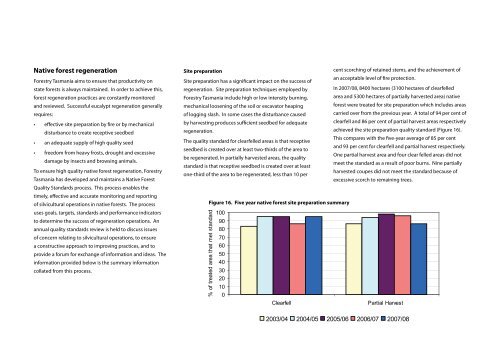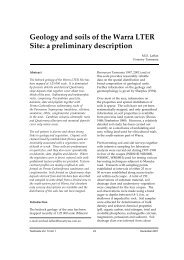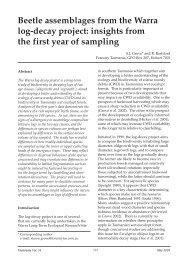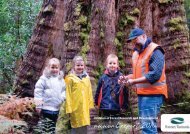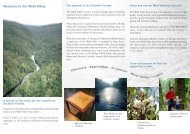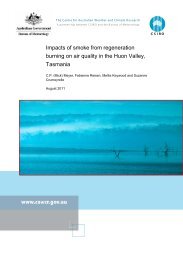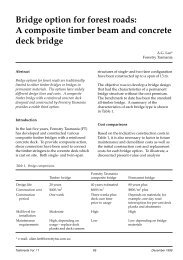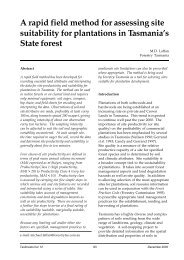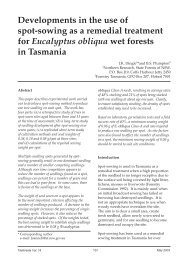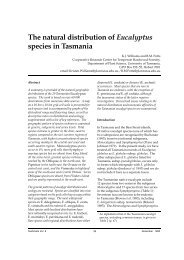sustainable forest management - Forestry Tasmania
sustainable forest management - Forestry Tasmania
sustainable forest management - Forestry Tasmania
You also want an ePaper? Increase the reach of your titles
YUMPU automatically turns print PDFs into web optimized ePapers that Google loves.
Native <strong>forest</strong> regeneration<br />
<strong>Forestry</strong> <strong>Tasmania</strong> aims to ensure that productivity on<br />
state <strong>forest</strong>s is always maintained. In order to achieve this,<br />
<strong>forest</strong> regeneration practices are constantly monitored<br />
and reviewed. Successful eucalypt regeneration generally<br />
requires:<br />
• effective site preparation by fire or by mechanical<br />
disturbance to create receptive seedbed<br />
• an adequate supply of high quality seed<br />
• freedom from heavy frosts, drought and excessive<br />
damage by insects and browsing animals.<br />
To ensure high quality native <strong>forest</strong> regeneration, <strong>Forestry</strong><br />
<strong>Tasmania</strong> has developed and maintains a Native Forest<br />
Quality Standards process. This process enables the<br />
timely, effective and accurate monitoring and reporting<br />
of silvicultural operations in native <strong>forest</strong>s. The process<br />
uses goals, targets, standards and performance indicators<br />
to determine the success of regeneration operations. An<br />
annual quality standards review is held to discuss issues<br />
of concern relating to silvicultural operations, to ensure<br />
a constructive approach to improving practices, and to<br />
provide a forum for exchange of information and ideas. The<br />
information provided below is the summary information<br />
collated from this process.<br />
Site preparation<br />
cent scorching of retained stems, and the achievement of<br />
an acceptable level of fire protection.<br />
Site preparation has a significant impact on the success of<br />
regeneration. Site preparation techniques employed by<br />
In 2007/08, 8400 hectares (3100 hectares of clearfelled<br />
<strong>Forestry</strong> <strong>Tasmania</strong> include high or low intensity burning,<br />
area and 5300 hectares of partially harvested area) native<br />
mechanical loosening of the soil or excavator heaping<br />
<strong>forest</strong> were treated for site preparation which includes areas<br />
of logging slash. In some cases the disturbance caused<br />
carried over from the previous year. A total of 94 per cent of<br />
by harvesting produces sufficient seedbed for adequate<br />
clearfell and 86 per cent of partial harvest areas respectively<br />
regeneration.<br />
achieved the site preparation quality standard (Figure 16).<br />
This compares with the five-year average of 85 per cent<br />
The quality standard for clearfelled areas is that receptive<br />
and 93 per cent for clearfell and partial harvest respectively.<br />
seedbed is created over at least two-thirds of the area to<br />
One partial harvest area and four clear felled areas did not<br />
be regenerated. In partially harvested areas, the quality<br />
meet the standard as a result of poor burns. Nine partially<br />
standard is that receptive seedbed is created over at least<br />
harvested coupes did not meet the standard because of<br />
one-third of the area to be regenerated, less than 10 per<br />
excessive scorch to remaining trees.<br />
Figure 16. Five year native <strong>forest</strong> site preparation summary<br />
% of treated area that met standard<br />
100<br />
90<br />
80<br />
70<br />
60<br />
50<br />
40<br />
30<br />
20<br />
10<br />
0<br />
Clearfell<br />
Partial Harvest<br />
2003/04 2004/05 2005/06 2006/07 2007/08


